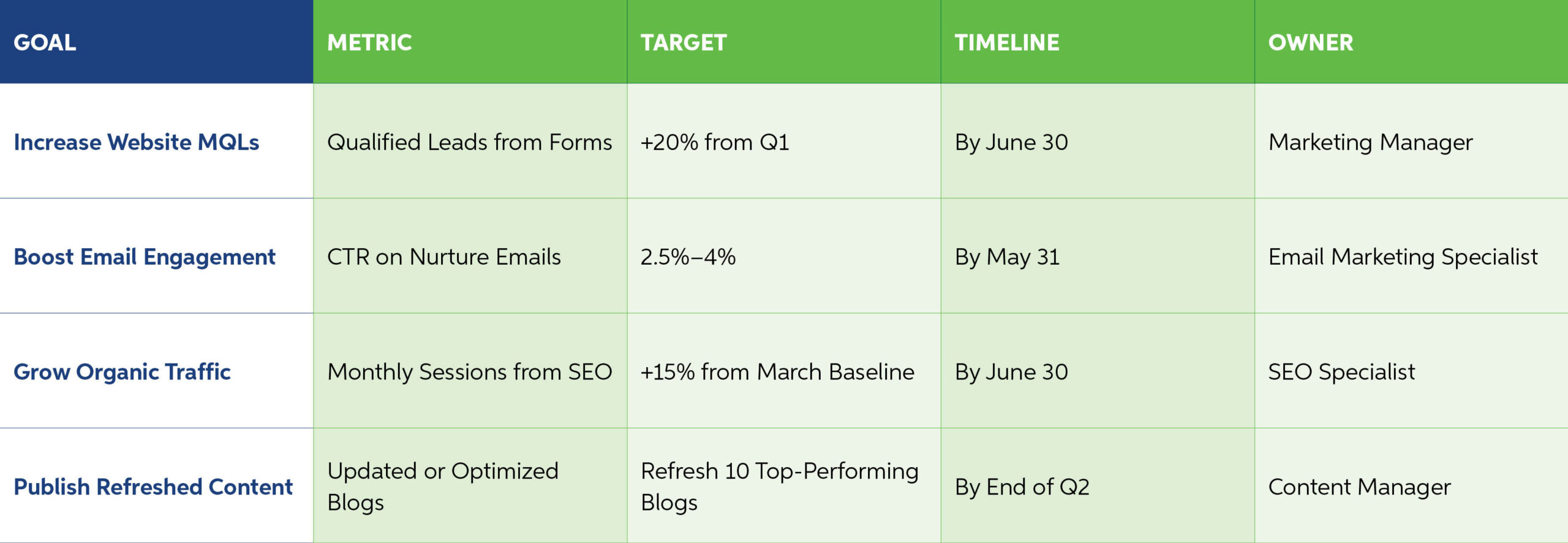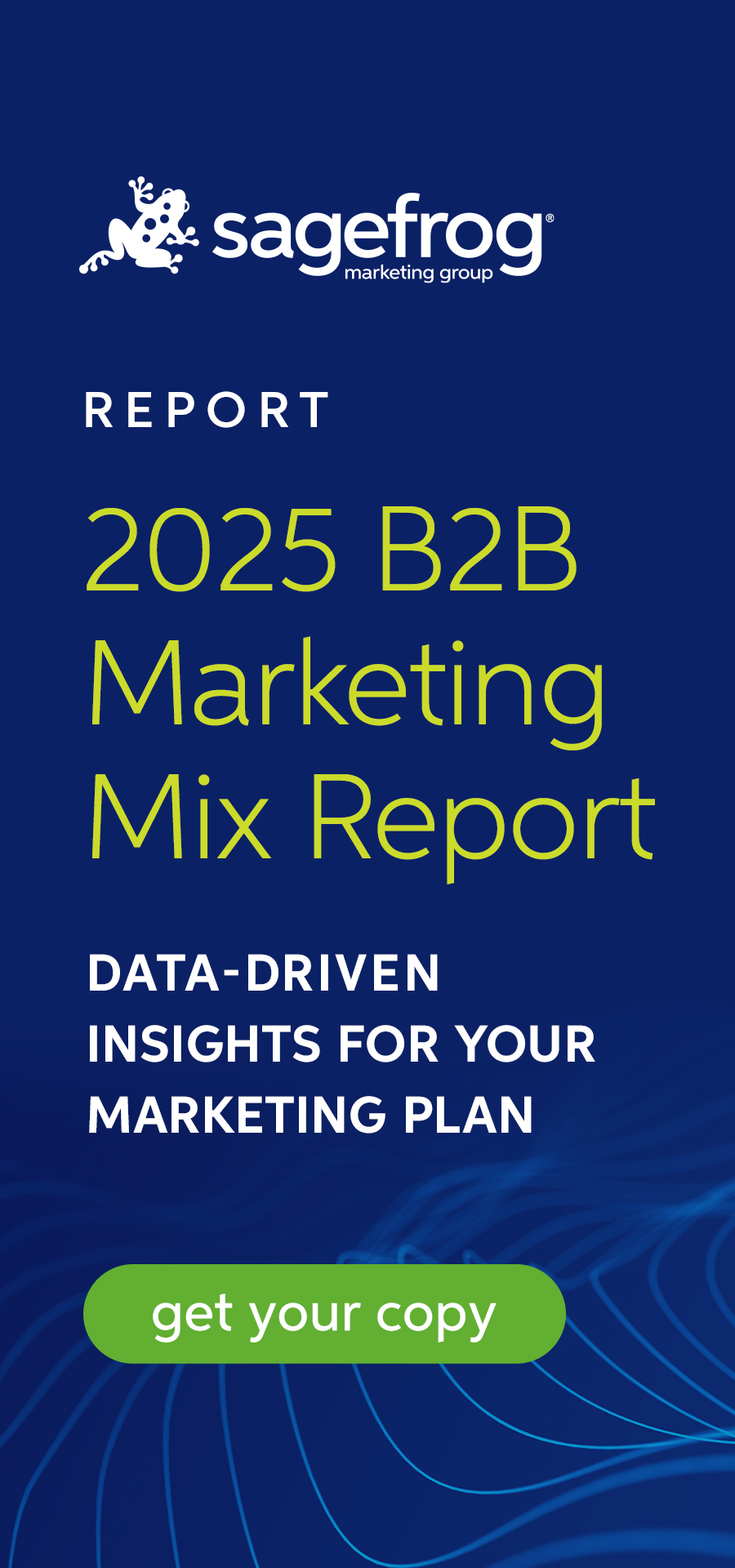As the weather warms and flowers bloom, it’s the perfect time to “spring clean” your B2B marketing plan. Q2 offers a natural opportunity to refresh your strategy and shake off any Q1 stagnation.
But this isn’t just a poetic metaphor—Q2 is a critical checkpoint. With three quarters left, timely adjustments can significantly impact your year-end results. A mid-year strategy reset keeps your team agile and aligned, preventing the “set it and forget it” trap. Companies that proactively refine their plans often build momentum, gaining a competitive edge over those who take a “wait and see” approach.
Table of Contents
- B2B Marketing Audit: Sweep Out the Clutter
- B2B Content Marketing Ideas: Dust Off Your Messaging
- B2B Marketing Tools: Organize Your Tech Stack
- B2B Marketing Campaigns: Replant Growth Opportunities
- B2B Marketing Data: Set SMART Marketing Goals for Q2
- B2B Marketing Goals: Final Touches
- Clear the Dust, Plant for Growth
B2B Marketing Audit: Sweep Out the Clutter
A successful Q2 starts with a clear understanding of what’s working and what’s not. Conduct a marketing audit to refine your strategy and maximize ROI.
- Evaluate ROI: Identify which campaigns drove the most leads, conversions, and revenue. Determine standout successes and underperformers.
- Analyze Key Metrics: Focus on CTR, conversion rates, and the progression from MQL to SQL.
- Leverage Multi-Touch Attribution: Go beyond last-click models to see how multiple touchpoints contribute to conversions.
Every channel should serve a clear purpose and deliver measurable value. If not, it may be time to pivot or pause. Evaluate these areas:
- Paid Channels: Review spending on platforms like Google Ads and LinkedIn. If ROI falls short, consider reallocating your budget to higher-performing channels.
- Organic Channels: Assess blog performance. Are you ranking for relevant keywords and driving qualified traffic?
- Social Media: Check engagement. Are your posts resonating with your audience and supporting business goals?
- Email Marketing: Review metrics like open and click-through rates. If results are stagnant, segments may be outdated or too broad.
Lastly, clean up your CRM. Outdated data distorts reporting and wastes resources. Remove unsubscribers, hard bounces, and duplicates. Segment your contacts by relevant factors like industry, job title, or product interest to personalize your outreach and drive stronger results.
B2B Content Marketing Ideas: Dust Off Your Messaging
Do your core messaging, value propositions, and Ideal Customer Profiles (ICPs) reflect current market trends? Q1 may have surfaced new pain points or industry shifts, so adjust your content accordingly. Even strong value propositions can benefit from minor tweaks to stay relevant in 2025.
Next, update your best-performing evergreen content. Refreshing existing content can yield big results, with 53% of marketers seeing increased engagement and 49% reporting higher traffic.1 Incorporate recent stats, add insights, and optimize for SEO to extend its impact. A few strategic updates can nearly double traffic. Start with 5–10 top pieces from Q1 and give them a quick polish.
Beyond refreshing old assets, you can also try introducing new formats, such as:
- Interactive tools like ROI calculators or quizzes to engage prospects and capture data
- Benchmark reports and checklists for actionable comparisons and insights
- Comparison guides offering side-by-side evaluations to support buying decisions
- Repurposed content from webinars into blogs, videos, or infographics for a wider reach
You can further boost visibility by collaborating with industry publications or associations. Publish thought leadership articles, contribute to niche blogs, or partner on content. Align with sales to address key Q1 questions and objections in your content, ensuring it supports the buyer’s journey.
B2B Marketing Tools: Organize Your Tech Stack
Many teams accumulate platforms for automation, analytics, CRM, ABM, and more, but not all may deliver value. In Q2, evaluate your MarTech stack for opportunities to consolidate and optimize.
- List Your Tools: Document all major platforms used by marketing and sales (e.g., HubSpot, Salesforce, marketing automation, email, analytics, SEO tools).
- Evaluate Usage & Value: Are the tools actively used? Are they contributing to results?
- Identify Redundancies: Are multiple tools performing the same function? Consolidate where possible.
- Spot Underutilized Tools: Are any platforms rarely used? Eliminate or optimize them.
With 44% of the average MarTech stack going unused, consolidating tools can free up budget for more impactful investments.2 For example, if multiple departments use different email platforms, unify under one. If premium analytics software isn’t adding value, consider free alternatives like Google Analytics or rely on your CRM’s built-in reporting.
Evaluate whether your tools are working together seamlessly. Can they “talk to each other” to support automated workflows and unified reporting? As you plan for 2025, ask yourself if your current tech stack aligns with your goals, whether it’s ABM, AI-driven analytics, or other priorities.
Refresh automations and configurations to stay aligned with current behavior. Adjust lead scoring models based on stronger buying signals like webinar attendance or repeated pricing page visits. Update chatbot scripts, nurture sequences, and CTAs to reflect recent insights.
Finally, maximize tool utilization. If a valuable platform is underused, invest in training instead of discarding it. Companies like Sagefrog curate efficient MarTech stacks using tools like HubSpot, SEMrush, and Hootsuite—maintaining what works, eliminating what doesn’t, and empowering teams to get the most out of their tech.
B2B Marketing Campaigns: Replant Growth Opportunities
Q2 is the perfect time to refresh your B2B campaigns. After auditing performance and updating content, explore new formats and channels to better engage your audience. Here are a few ideas:
- Host Interactive Webinars or Virtual Events: Host Q&A sessions, panels, or roundtables for mid-year budget planners, then repurpose recordings as on-demand content.
- Video Sequences & Podcasts: Boost engagement with short video emails from executives or product experts, or expand your reach by launching or partnering on a niche podcast.
- Account-Based Marketing (ABM) Campaigns: Personalize outreach with tailored emails, LinkedIn retargeting, and direct mail. 97% of marketers report higher ROI with ABM.3
- Leverage Intent Data: Identify companies researching relevant topics and trigger targeted campaigns or timely sales outreach.
- Customer Marketing Programs: Build loyalty with advocacy or referral programs, exclusive webinars, and community forums to boost retention and growth.
B2B Marketing Data: Set SMART Marketing Goals for Q2
Reassess your marketing KPIs based on Q1 performance to ensure they align with sales goals and company objectives. Consider goals like increasing MQL to SQL conversion rates by 15%, shortening the sales cycle by 10 days, or reducing CPL by 20% through better targeting. Build these objectives into your project management system (e.g., Asana, ClickUp) and set monthly checkpoints to stay accountable. SMART goals help ensure your goals are clear and achievable:
- Specific: Clearly define your objective.
- Measurable: Track progress with clear metrics.
- Achievable: Set realistic targets.
- Relevant: Align goals with broader company objectives.
- Time-Bound: Establish a deadline to stay on track.
Here’s an example of SMART goals work in practice:
B2B Marketing Goals: Final Touches
Before wrapping up your spring cleaning, address small issues that can quietly impact your marketing performance. These quick fixes can significantly enhance user experience and engagement:
- Repair broken links, update outdated CTAs, and optimize slow-loading pages.
- Remove unused landing pages and clean up non-responsive email templates.
- Ensure images have alt text, use readable fonts, and prioritize mobile-first design.
- Incorporate micro-animations, playful copy, or hidden Easter eggs to create memorable user experiences.
These minor adjustments can lead to major improvements in website performance, user satisfaction, and brand perception.
Clear the Dust, Plant for Growth
A refreshed B2B marketing strategy isn’t just about fixing what’s broken; it’s about setting yourself up for growth. By auditing campaigns, optimizing content, streamlining your tech stack, and refining goals, you’ll build a solid foundation for the rest of the year.
You don’t have to tackle everything at once. Prioritize the changes with the biggest impact and build momentum from there. So, roll up your sleeves, clear the dust, and plant the seeds for a successful year. Team up with Sagefrog to tackle your Q2 spring cleaning and get a head start on planning for Q3. Your future results will thank you.
References:


